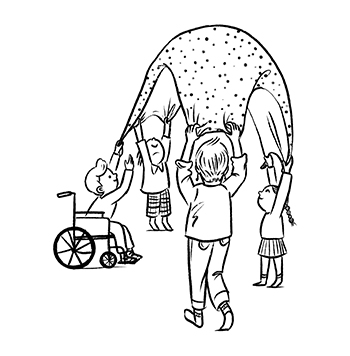Parachute play: why it’s good for children disability, autism or other additional needs
In parachute play, a group of people works together to move a large piece of material up and down. The material is like a parachute filling with air.
Parachute play helps children with disability, autism or other additional needs develop teamwork skills. It can also help with gross motor skill development. And it helps children connect with others.
Parachute play can be good for children at stressful times. This is because parachute play can help children release energy and emotions. This is particularly good for children who are feeling strong or overwhelming emotions.

What you need for parachute play
All you need for parachute play is:
- a large piece of material – for example, a blanket or sheet
- at least 2 people.
Note that thinner material will float and catch the air better. You can also make a smaller parachute using a towel.
How to do parachute play
You and your child could do parachute play together. Your child could also do this activity with a group of people, including adults, older children and young children.
Here’s how to get started with your child or a group of players:
- Lay a piece of material flat on the ground.
- Stand around the material at equally spaced distances. If there are 2 of you, stand opposite each other.
- Take hold of the edge of the material. Lift the material off the ground together.
- Slowly and calmly lift the material as high as you can. Then lower the material as low as you can.
- Lift and lower several times and then begin to increase or vary the pace.
Ideas and options
- Make the parachute move in different ways. For example, make it move like waves in a storm – calm and steady at first, and faster and rougher as the wind picks up. This can spark children’s imaginations.
- Encourage players to take turns to lie down underneath the moving parachute. This can be a safe space for children. Some might also find the movement of the material soothing.
- Raise the parachute high and encourage players to run, wheel, crawl or slide beneath it. This can be good for children with a lot of energy.
- Bounce a toy on top of the moving parachute. Increase the speed and height of the material, while trying to keep the toy in the centre. This gets the group working together and can be good for connection.
Some children might be better at balancing than others. To keep everyone safe, avoid strong movements like sudden tugging or jumping on the fabric while people are holding it.
How to adapt parachute play to suit children with diverse abilities
You can do parachute play with a mix of children of different ages and diverse abilities.
For example, children with restricted mobility might need you or another carer to help them move the material.
Children who have difficulty with fine motor skills might need you or another carer to help them handle or grip the material. Or you could tie a knot in the corner of the material so children can get a better grip on it.
For children with sensory sensitivities, you could introduce the movements of the material more gradually and check in with your child regularly to make sure they’re enjoying it.
Looking for more play and learning ideas for your child? You might like to explore our other activity guides. Some of these have been created for typically developing children, but they can all be adapted to suit children with diverse strengths and abilities.